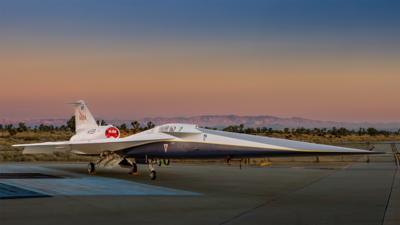Mon, Jan 15, 2024
New Supersonic Prototype Aims to Soften the Blow When Going Beyond Mach 1
No more CGI for the next-gen x-plane from NASA and Lockheed Martin now that the duo has finally debuted the quiet supersonic aircraft live in the metal.

The X-59 Quesst aircraft is a demonstrator to bear out the possibility of supersonic flight without the sonic booms. If successful, the concept will revolutionize public air travel with a whole new niche of high-flying, fast-moving, supersonic aircraft. The Concorde took a swing at the supersonic passenger craft idea, but it ultimately died a slow, expensive market death as its destinations limited its performance to reduce noise on the ground. That apparently ended supersonic pax carriage for good, but new money, new ideas, and fresh materials lie ready and waiting to take another crack at the market.
“This is a major accomplishment made possible only through the hard work and ingenuity from NASA and the entire X-59 team,” said NASA Deputy Administrator Pam Melroy. “In just a few short years we’ve gone from an ambitious concept to reality. NASA’s X-59 will help change the way we travel, bringing us closer together in much less time.”
Melroy was joined by brass from Lockheed and NASA at a ceremony revealing the Quesst demonstrator at the former's Skunk Works facility in Palmdale, California. The aircraft, if successful, won't necessarily be completely free of sonic booms, however. NASA wants to reduce the effect of the supersonic crack with sculpting, shaping, and materials placement that will slough off and delay the transition to supersonic along the body of the aircraft. If successful, the Quesst demonstrator will hit its supersonic cruise of 925 mph or 1.4 mach with a quiet "thump" instead of a loud "boom".
“It’s thrilling to consider the level of ambition behind Quesst and its potential benefits,” said Bob Pearce, associate administrator for aeronautics research at NASA Headquarters in Washington. “NASA will share the data and technology we generate from this one-of-a-kind mission with regulators and with industry. By demonstrating the possibility of quiet commercial supersonic travel over land, we seek to open new commercial markets for U.S. companies and benefit travelers around the world.”
More News
From 2023 (YouTube Edition): New Propulsion Scheme Optimized for AAM Applications Founded in 2017 by Eric Bartsch, Pat Anderson, and Erik Lindbergh (grandson of famed aviation pion>[...]
During The Initial Climb, The Engine Began To Operate Abnormally And, After About Three Seconds, Experienced A Total Loss Of Power On October 29, 2025, about 1820 Pacific daylight >[...]
Aero Linx: Women in Aviation International Women in Aviation International is the largest nonprofit organization that envisions a world where the sky is open to all, and where avia>[...]
“We’ve paid for the cable line’s repair for the customer and have apologized for the inconvenience this caused them...” Source: Some followup info from an A>[...]
“We have long warned about the devastating effects of pairing optimization. Multiple times over many months, we highlighted how schedule manipulation, unbalanced schedules, a>[...]
 Classic Aero-TV: VerdeGo Debuts VH-3 Hybrid-Electric Powerplant
Classic Aero-TV: VerdeGo Debuts VH-3 Hybrid-Electric Powerplant NTSB Prelim: Grumman American Avn. Corp. AA-5B
NTSB Prelim: Grumman American Avn. Corp. AA-5B ANN's Daily Aero-Linx (12.02.25)
ANN's Daily Aero-Linx (12.02.25) Aero-News: Quote of the Day (12.02.25)
Aero-News: Quote of the Day (12.02.25) Aero-News: Quote of the Day (12.03.25)
Aero-News: Quote of the Day (12.03.25)



